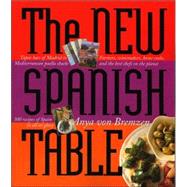
| Introduction: Falling in Love with Spain | p. xiii |
| The Regions of Spain | p. 2 |
| Tapas: Little Bites, Big Tastes | p. 18 |
| Soup: From Cozy to Cool | p. 74 |
| Salads: So Fresh, So Good | p. 110 |
| Eggs: More Than Breakfast | p. 136 |
| Empanadas: Canapes, Cocas & More | p. 158 |
| Seafood: Sophisticated Simplicity | p. 184 |
| Meat: Pork, Lamb, and Beef | p. 228 |
| Poultry: And Game | p. 270 |
| Beans and Potatoes: Rustic Elegance | p. 302 |
| Rice and Pasta | p. 330 |
| Vegetables: Luxuriously Perfect | p. 366 |
| Desserts: The Grand Finale | p. 396 |
| Conversion Tables | p. 454 |
| The Spanish Pantry | p. 455 |
| Utensils | p. 460 |
| Sources | p. 461 |
| Photography Credits | p. 463 |
| Index | p. 464 |
| Table of Contents provided by Ingram. All Rights Reserved. |
The New copy of this book will include any supplemental materials advertised. Please check the title of the book to determine if it should include any access cards, study guides, lab manuals, CDs, etc.
The Used, Rental and eBook copies of this book are not guaranteed to include any supplemental materials. Typically, only the book itself is included. This is true even if the title states it includes any access cards, study guides, lab manuals, CDs, etc.
Excerpted from The New Spanish Table by Anya Von Bremzen
All rights reserved by the original copyright owners. Excerpts are provided for display purposes only and may not be reproduced, reprinted or distributed without the written permission of the publisher.